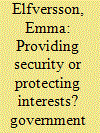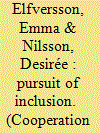|
|
|
Sort Order |
|
|
|
Items / Page
|
|
|
|
|
|
|
| Srl | Item |
| 1 |
ID:
147077


|
|
|
|
|
| Summary/Abstract |
Under what circumstances can non-state actors become successful local peacemakers? A growing body of research documents the involvement of non-state actors in local conflict resolution in Africa. However, there is large variation in such actors' power, legitimacy, and ultimately their ability to contribute to conflict resolution. The ways in which contextual and dynamic factors at local and national levels, and in particular the relationship between non-state and state actors and institutions, affect local conflict resolution are not sufficiently understood. To address this gap, this paper analyses the peace process addressing a long-standing conflict in Kerio Valley, Kenya. The analysis illustrates how the failure of the state to provide security and basic services led non-state actors to fill important roles in governance. Through this process, they were endowed with legitimacy and power which enabled them to play key roles in a peace process that led to a mutually acceptable peace agreement.
|
|
|
|
|
|
|
|
|
|
|
|
|
|
|
|
| 2 |
ID:
142045


|
|
|
|
|
| Summary/Abstract |
What factors drive governments’ decisions to intervene in local conflicts within their borders? Communal conflict – that is, organized violence between non-state groups that are mobilized along a shared communal identity – kills thousands each year and severely impacts local livelihoods, at times threatening to spread and affect entire regions. Given the state’s assumed monopoly over the legitimate use of force, we should expect the concerned governments to be critical actors of the overall effort to restore peace in cases of local communal conflict, but empirical evidence indicates that central states tend to only intervene in some cases but not in others. This phenomenon has so far been understudied and the variations in states’ efforts to manage these conflicts remain unexplained. This article presents the first quantitative study of state intervention in communal conflicts. Building on existing scholarly work, I argue that state intervention is explained by a combination of strategic interests and state capacity, and that interests related to ethnic constituencies and land control play an important part in explaining governments’ strategies. These propositions find support in a statistical analysis covering sub-Saharan Africa from 1989 to 2010.
|
|
|
|
|
|
|
|
|
|
|
|
|
|
|
|
| 3 |
ID:
185242


|
|
|
|
|
| Summary/Abstract |
Why are some peace processes in communal conflicts more inclusive of civil society actors than others? Inclusion of civil society actors, such as churches and religious leaders, women’s organizations, or youth groups, is seen as important for normative reasons, and studies also suggest that civil society inclusion can improve the prospects for durable peace. Yet, we have a very limited understanding of why we observe inclusion in some communal conflicts but not others. We address this gap by theorizing about various forms of civil society inclusion in local peace processes, and examining to what extent involvement by different types of third-party actors—governments, inter-governmental organizations (IGOs), and non-governmental organizations (NGOs)—may contribute to inclusion. Empirically, we draw on a combination of cross-case and in-depth data covering peace negotiations in communal conflicts in Kenya. The findings show that civil society was less frequently included as facilitators when the government was involved as a third party, while inclusion in the form of direct participation of civil society in negotiations, or via involvement in the implementation phase, was equally common across different types of third-party actors. Our study thus provides important new insights regarding how inclusion plays out in communal conflicts.
|
|
|
|
|
|
|
|
|
|
|
|
|
|
|
|
|
|
|
|
|